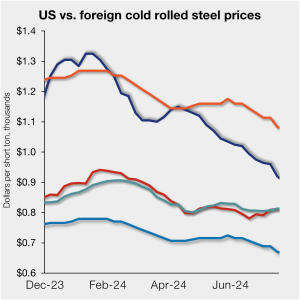
Offshore CR still cheaper despite lower US prices
The price gap between US cold-rolled (CR) coil and imported CR tightened marginally after falling to a 10-month low in late July.

The price gap between US cold-rolled (CR) coil and imported CR tightened marginally after falling to a 10-month low in late July.
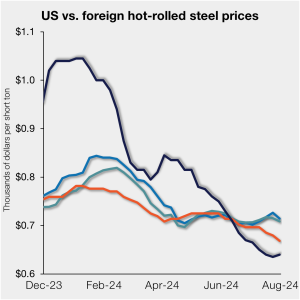
The premium between US hot-rolled (HR) coil and offshore hot band prices narrowed this week as it appears domestic tags might have reached a bottom.

Nearly 1,200 people have registered for SMU Steel Summit, which is less than a month away now. That means we’re still on pace to meet or exceed last year’s record attendance despite a tough flat-rolled steel market over the last few months. So, a big thank you to everyone who already plans to go for your continued support. If you haven’t booked travel yet, don’t miss out on one of the greatest shows in steel – register here. (You can also check out the latest agenda here.)

Nucor’s top executive expressed concerns over unfair trade practices, highlighting increased steel imports from Mexico and Canada.
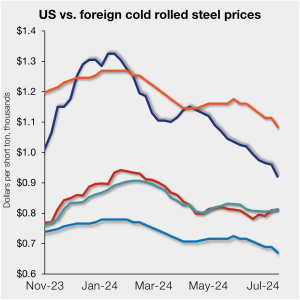
The price gap between US cold-rolled (CR) coil and imported CR has fallen to a 10-month low as domestic tags continue to drift lower. Domestic CR coil prices averaged $920 per short ton (st) in our check of the market on Tuesday, July 16, down $40/st from the week before. CR tags are now down […]

I thought we’d have more clarity this week on Section 232, Mexico, and a potential carve-out for steel melted and poured in Brazil. As of right now, the only official comment I have is from the Office of the United States Trade Representative (USTR).
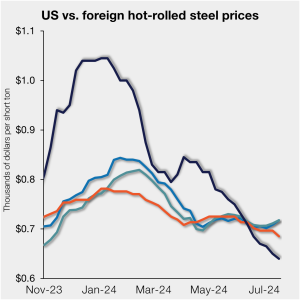
US hot-rolled (HR) coil prices this week drifted further below offshore hot band prices on a landed basis. The premium is now near a two-year low. SMU’s check of the market on Tuesday, July 16, put domestic HR coil tags at $640 per short ton (st) on average, down $10/st from last week. Stateside hot […]

There are a lot of rumors swirling around the steel market over the last couple of weeks. Chief among them was that we might see a price hike after Independence Day. Another concerns a key detail in the new Section 232 agreement with Mexico. Namely, steel imported from Brazil into Mexico. Of particular interest is its potential implication for slabs imported from Brazil, rolled in Mexico, and then exported to the US.

Steel is, mostly for historical reasons, a bellwether of international policy. No longer an industry of primary importance, its advocates still proclaim that it is. And steel still continues to punch above its weight in Washington, DC. Below are a few recent examples.
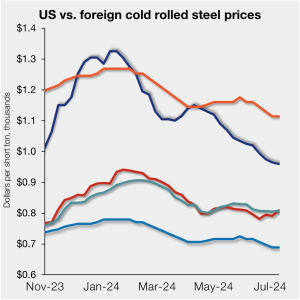
Offshore cold-rolled (CR) coil remains cheaper than domestic product. The gap continues to tighten, however, as US CR coil prices slip to a nine-month low. Domestic CR coil tags averaged $960 per short ton (st) in our check of the market on Tuesday, July 9, down $5/st from the week before. CR tags are now […]

Renewable energy infrastructure, including wind turbines, solar farms, and electric-vehicle charging stations, requires substantial amounts of steel. The domestic steel industry, with its capacity to produce world-class steel with the world’s smallest carbon footprint, should be at the forefront of this supply chain. Yet the United States is increasingly importing steel from abroad to meet its renewable energy needs.

The Mexican government said on Thursday that it had negotiated a temporary carve out for Brazilian steel in recently updated Section 232 rules. Mexico said that the pact would stretch until 2027, by which point all steel exported to the US would have to me “melted and poured” within North America.
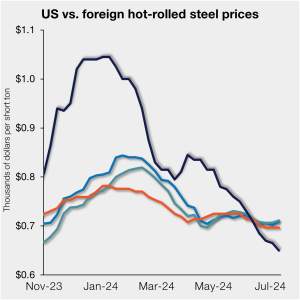
US hot-rolled (HR) coil prices continued to drift lower this week, falling further below imported hot band tags on a landed basis. SMU’s check of the market on Tuesday, July 9, put domestic HR coil tags at $650 per short ton (st) on average, down $15/st vs. last week. Domestic HR coil prices are now […]

The US and Mexico announced measures on Wednesday to prevent tariff evasion and protect North America’s steel and aluminum industries.
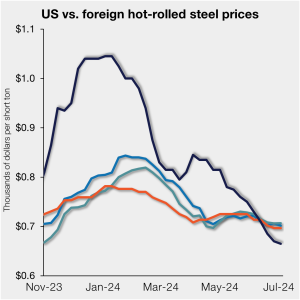
US hot-rolled (HR) coil prices fell again this week – now on a 13-week run – causing tags to drift further below offshore hot band prices on a landed basis.
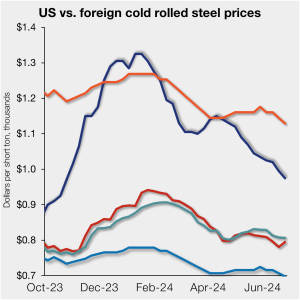
Offshore cold-rolled (CR) coil remains cheaper than domestic product pricing even as US CR coil prices slip to an eight-month low. Domestic CR coil tags stood at $975 per short ton (st) on average in our check of the market on Tuesday, June 25, down $20/st from the week before. Domestic CR prices are, on […]
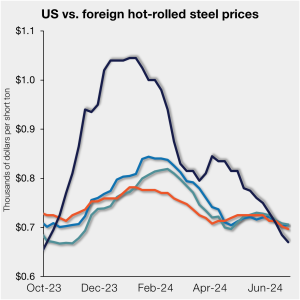
US hot-rolled (HR) coil prices have continued to drift lower, pushing them further below offshore hot band prices on a landed basis.
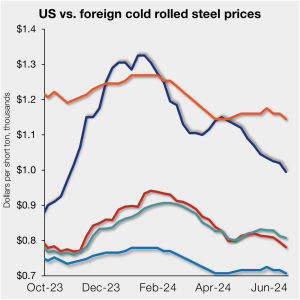
Offshore cold-rolled (CR) coil prices are cheaper than domestic product despite US CR coil prices ticking lower. Domestic CR coil tags stand at $995 per short ton (st) on average, down $25/st vs. our prior check of the market on Tuesday, June 18. (We will update prices again on Tuesday, June 25.) All told, US […]

The chairman of a large American steel company called for Mexico to be dropped from USMCA at a steel industry conference last week. This follows earlier calls from members of Congress to reinstate Section 232 duties on Mexico. How did we get to this point?
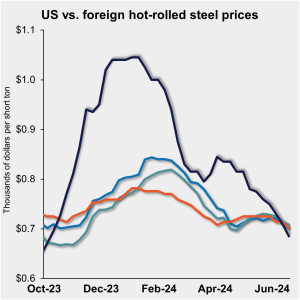
US hot-rolled (HR) coil prices fell further this past week, pushing them below offshore hot band prices on a landed basis.
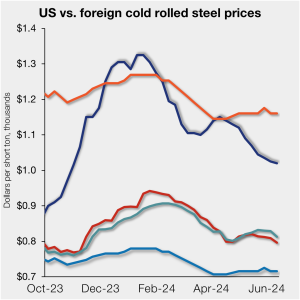
Offshore cold-rolled (CR) coil prices have changed little, but they are still notably cheaper than domestic product. That remains the case even as US CR coil prices ticked lower this week.

A roundup of recent aluminum news from CRU.
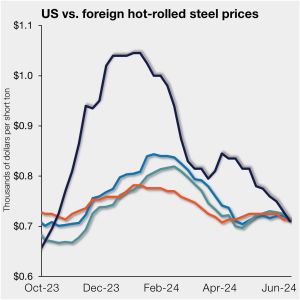
US hot-rolled (HR) coil prices fell further this past week, bringing them even with offshore hot band prices on a landed basis.

The USMCA is an important trade agreement, as long as the member countries honor its requirements. These were the sentiments echoed by top officials of the Steel Manufacturers Association (SMA) and Metals Service Center Institute (MSCI) during a press conference at their annual meeting last week in Scottsdale, Ariz.
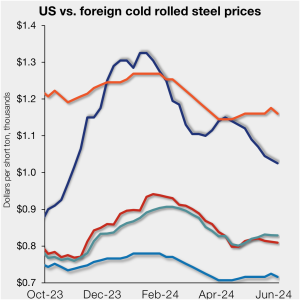
Offshore cold-rolled (CR) coil prices remain notably cheaper than domestic product. That remains the case even as US CR coil prices continue to tick lower.
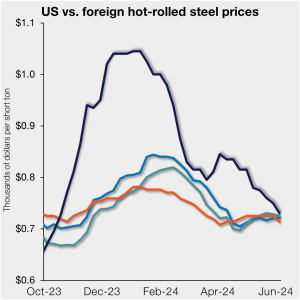
US hot-rolled (HR) coil prices ticked down again this past week, nearly reaching parity with offshore hot band prices on a landed basis. This week, domestic HR coil tags were $730 per short ton (st) on average based on SMU’s latest check of the market on Tuesday, June 4. Domestic HR coil prices are now […]
When you step out of the airport in Phoenix in June, the heat tends to focus your mind. I was in town to attend the Steel Manufacturers Association/Metals Service Center Institute (MSCI) annual meeting in Scottsdale, Ariz. The desert locale with palm trees, swimming pools, and the obligatory high-powered air conditioning was fitting for 2024. Between the presidential election and the geopolitical situation, things have definitely been heating up.

President Joe Biden announced that the US will extend the suspension of Section 232 tariffs on steel products imported from Ukraine for another year. The Biden administration first lifted the 25% Section 232 tariffs on steel imports from Ukraine after the breakout of war with Russia in 2022. The initial waiver was good for one […]

Hot-rolled coil prices are known for their volatility. There are a variety of hedging strategies industry players have used to manage it, one of them being the use of HRC futures. However, some have been hesitant to dip in their toe, and their money, in futures and have preferred other approaches.
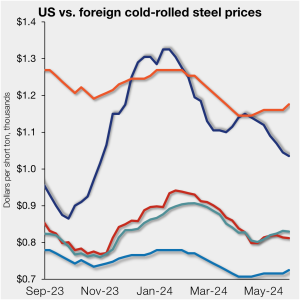
Offshore cold-rolled (CR) coil prices remain significantly cheaper than domestic product. That remains the cause even as US CR coil prices continued to tick lower. All told, US CR prices are now 17.6% more expensive than imports. While still high, that premium is down from 19.4% last week and down from 31.5% in early January.